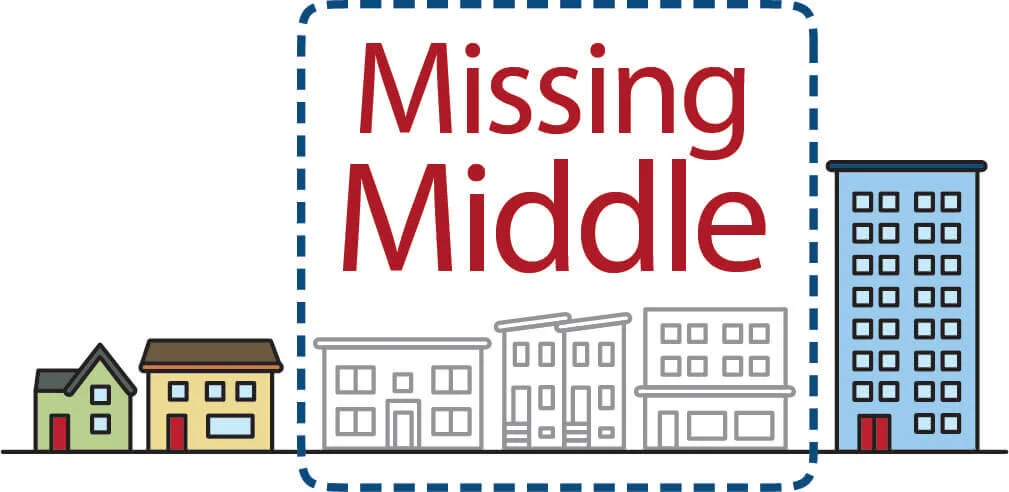The Missing Middle, Zoned-Out
In the past decade, Calgary’s young professionals have been in decline along with its oil-based economy. While a lack of employment is certainly a contributing factor, I think there is a more tangible reason they’re unable to live here: Calgary’s missing middle housing. The only way to fill in this gap and provide greater housing diversity is to overhaul our land-use bylaw, and the Guide for Local Area Planning is the first step.
Young professionals can’t afford to live here
A recent discussion on CBC’s Unconventional Panel highlighted Calgary’s dwindling younger demographic. These young professionals have relatively low incomes as their careers are in their infancy. This limits housing choice purely from a financial standpoint, regardless of whether they’re renting or buying. In Calgary, if you want to live near downtown or the beltline where you work, socialize, and have ample amenities, you’re looking at purchase prices in the $400-700 per square foot range, regardless of whether its a single-family home or a high-rise bachelor suite. The price similarity between these polar ends of the spectrum of housing form is ultimately caused by our conventional zoning, which has restricted two-thirds of all Calgary’s residential lands to single-family housing.
The scarcity of land available for other types of residential buildings causes land values to rise, while pushback from NIMBY neighbours against anything other than single-family homes increases development risk. Together, this pushes developers to build taller just to warrant the investment. Meanwhile single-family lots, when redeveloped, get maximized in size and luxury to get the greatest returns. In either scenario, the dwellings reach similar market prices per square foot. This leaves the young professional with a choice of smaller spaces or larger commutes from areas with less expensive land. If one opts for the commute, then additional travel expenses have to be factored in that could again push them further toward the periphery or ultimately prevent them from living in Calgary altogether. I believe this to be the case for our dwindling young professionals; what they need is housing options in the middle, both in size and price.
The ‘Missing Middle’
Image from MissingMiddleHousing.com
The factors above have limited inner-city redevelopment to single-family homes or high-rise apartments, leaving a gap in the market called the missing middle. These missing housing forms include rowhousing, triplexes/fourplexes, cottage clusters, walk-up apartments, and live-work units. In recent years, Calgary has permitted secondary and backyard suites as options for single-family areas, as well as introduced new rowhouse zonings; both have been hugely popular for homeowners and developers alike, showing there is a hunger for new housing forms.
Unfortunately, many of Calgary’s current land-use bylaws (aka, zonings) are too restrictive for these forms to be built everywhere, so ideal lots (like block corners) skyrocket in value and force developers to aim for the luxury market in order to continue to make a profit. With current zoning policies in place, trying to fill in this housing gap en mass isn’t financially viable, as a recent Edmonton competition has proven.
To help remedy this situation, our current segregated-use zoning needs to be replaced with form-based codes, as Calgary is attempting to do with the Guide for Local Area Planning (formerly, Guidebook for Great Communities). By focusing on built form, the conversation shifts toward issues of scale and streetscape compatibility rather than density metrics, the building’s function, or its targeted demographic; it also introduces flexibility for a building’s future re-use or repurposing. By allowing a streetscape-compatible building to have any number of units so long as it meets all building and fire codes, homeowners and developers alike will have substantially more design freedom to create housing that begins to fill in the missing middle.
Form over Function
Zoning was introduced in the mid-twentieth century to separate “incompatible” uses, such as commercial offices from residential homes. Zoning has also been used as a tool for systemic elitism, called redlining, where exclusionary boundaries are drawn to maintain some trait within a community. This tactic reared its ugly head during the Guidebook’s public hearings on March 24-26, as droves of Elbow Park’s affluent residents voiced their concerns that the Guidebook will destroy the character of their community. This “character” is nothing more than a thinly-veiled attempt to restrict admittance to the community to those who can afford the high price tag.
Current zonings rely on metrics such as number and size of dwellings, floor area ratios, setback dimensions, or arbitrary height limits. Form-based codes address the relationship between a proposed development and the public realm. Issues of shape, scale, shadowing, and accessibility become the discussion as these affect the users, neighbours, and passers-by in tangible ways. Conventional zonings focus on buildings, whereas form-based codes focus on people.
Calgary has a number of old houses that had been converted to apartments before zoning policies stopped this practice. These conversions offer lower-priced dwellings to a neighbourhood without affecting the streetscape whatsoever; does it matter to the community if a house contains one or three families? As communities age and residents’ children move away, buildings, like schools, may no longer be needed. Current zoning practices prevent the repurposing of these buildings in many cases, which leads to demolition so the site can be re-zoned; this, is a true loss of character. Research increasingly shows that different uses all succeed much better when in close proximity, such as the same street or even the same building. Being able grab a coffee at the corner café on your walk to work then pick up groceries on your way home makes for a very livable neighbourhood!
Example: Redevelopment of a typical lot
A typical twenty-five foot wide inner-city lot can currently only host a single-detached house with a secondary/backyard suite at most (and that’s a tall order, given our parking minimums). With a form-based code, an equally-sized building could host three or four flats without any additional impact to the community. This takes the pressure off developers from having to maximize the house since it costs only slightly more to build a multi-plex (to meet building/fire codes), and would provide multiple dwellings at more affordable price-points that still achieve similar, if not greater, profits. Even downsizing home-owners could convert extra space into additional dwellings to help finance retirement without moving from their beloved community. But without form-based codes, these lots will continue to be redeveloped into more expensive dwellings, rather than more less-expensive ones.
Terraced ‘plexes in Montreal. Image from DynamicCities.org
The Guide is not enough
The Guide for Local Area Planning (formerly, Guidebook for Great Communities) is not nearly enough to drive developers to fill-in this missing middle. Parking minimums, minimum lot sizes, and side-yard setbacks must be eliminated where possible (without limiting firefighting access) to encourage greater density and variety while still offering the comforts of private yards or street-orientation. To address the affordability issue head-on, Calgary should also implement inclusionary measures to ensure large developments provide some lower-cost units.
Old-world cities, like London, Paris, Amsterdam, or even Montreal, have beautiful rowhouses of various widths that together span entire blocks. Some lots are three- or four-plexes, while others are single-family homes. By sandwiching them together they have densities that rival apartment complexes. No one who visits these cities claim they lack “character”. Even the adoption of tiny homes could become mainstream if there were inner-city lots to accommodate them. A standard corner lot, for example, could host an ‘eco-cottage cluster’ for five or six households who want to live tiny, but prefer amenities over remote forests.
TL:DR
For Calgary to really tackle its missing middle problem and attract young professionals to live here, a complete overhaul of the land-use bylaw is necessary. While the Guide for Local Area Planning is a good first step in this direction, the bylaws must follow suit to promote new housing configurations to be built within existing contexts. This will lower development risk by reducing discretionary decisions and increasing predictibility so new and innovative designs can meet the demand for missing middle housing forms at affordable price-points. By eliminating much of the mid-twentieth century’s auto-centric zoning bylaws, new housing innovations can, and will, happen.


